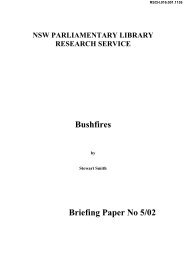Report on the Physical Nature of the Victorian Fires occurring on 7th ...
Report on the Physical Nature of the Victorian Fires occurring on 7th ...
Report on the Physical Nature of the Victorian Fires occurring on 7th ...
You also want an ePaper? Increase the reach of your titles
YUMPU automatically turns print PDFs into web optimized ePapers that Google loves.
EXP.003.001.0027<br />
Tolhurst (2009)<br />
“Describing The Black Saturday <strong>Fires</strong>”<br />
Stra<strong>the</strong>wen and Kinglake West ra<strong>the</strong>r than towards Whittlesea, but it also meant that<br />
firebrands were blown fur<strong>the</strong>r as well, reaching <strong>the</strong> area north <strong>of</strong> Healesville. This is a<br />
distance <strong>of</strong> about 35 km, with <strong>the</strong> previous l<strong>on</strong>gest spotting distance recorded being<br />
30 km from a fire in Gippsland. Similarly, <strong>the</strong> Churchill fire in south Gippsland threw<br />
firebrands 23 km from <strong>the</strong> top <strong>of</strong> <strong>the</strong> Strezlecki Range down to <strong>the</strong> Yarram area. The<br />
predicted spotting distance was <strong>on</strong>ly about 15 km, but because <strong>the</strong> winds were str<strong>on</strong>ger<br />
at <strong>the</strong> top <strong>of</strong> <strong>the</strong> range, embers were carried fur<strong>the</strong>r.<br />
The topography was also a factor in creating a fire induced wind str<strong>on</strong>g enough to snap<br />
<strong>of</strong>f trees in a gully in <strong>the</strong> Bunyip Ridge fire (Fig. 9). Winds would need to be in excess<br />
<strong>of</strong> 120 km/h to cause this type <strong>of</strong> damage.<br />
V<br />
• -<br />
-- •<br />
Figure 9.<br />
Gully <strong>of</strong> trees snapped <strong>of</strong> by high fire induced winds. Jack Road, Bunyip<br />
Ridge Fire. (Photo: Derek Ch<strong>on</strong>g, Uni. Melb.)<br />
Fire Itself<br />
The fire helps enhance itself as previously menti<strong>on</strong>ed, by creating it own local winds<br />
with indraughts into <strong>the</strong> c<strong>on</strong>vecti<strong>on</strong> column. It also enhances itself by producing and<br />
projecting firebrands to create spotfires ahead <strong>of</strong> itself. The degree to which <strong>the</strong> fire<br />
provides a positive feedback <strong>on</strong> its behaviour is influenced in part by <strong>the</strong> wea<strong>the</strong>r, <strong>the</strong><br />
fuel and <strong>the</strong> topography, but it also depends <strong>on</strong> <strong>the</strong> size <strong>of</strong> <strong>the</strong> fire.<br />
As a fire becomes larger, it tends to “see” <strong>the</strong> fuels and topography differently. Fire<br />
effectively integrates or averages out <strong>the</strong> fuels and topography within its “footprint”.<br />
The mechanism for doing this integrati<strong>on</strong> is <strong>the</strong> c<strong>on</strong>vecti<strong>on</strong> column.<br />
<str<strong>on</strong>g>Report</str<strong>on</strong>g> <strong>on</strong> <strong>the</strong> <strong>Physical</strong> <strong>Nature</strong> <strong>of</strong> <strong>the</strong> <strong>Victorian</strong> Fire <strong>occurring</strong> <strong>on</strong> <strong>7th</strong> February 2009.doc Page 11 <strong>of</strong> 18

















